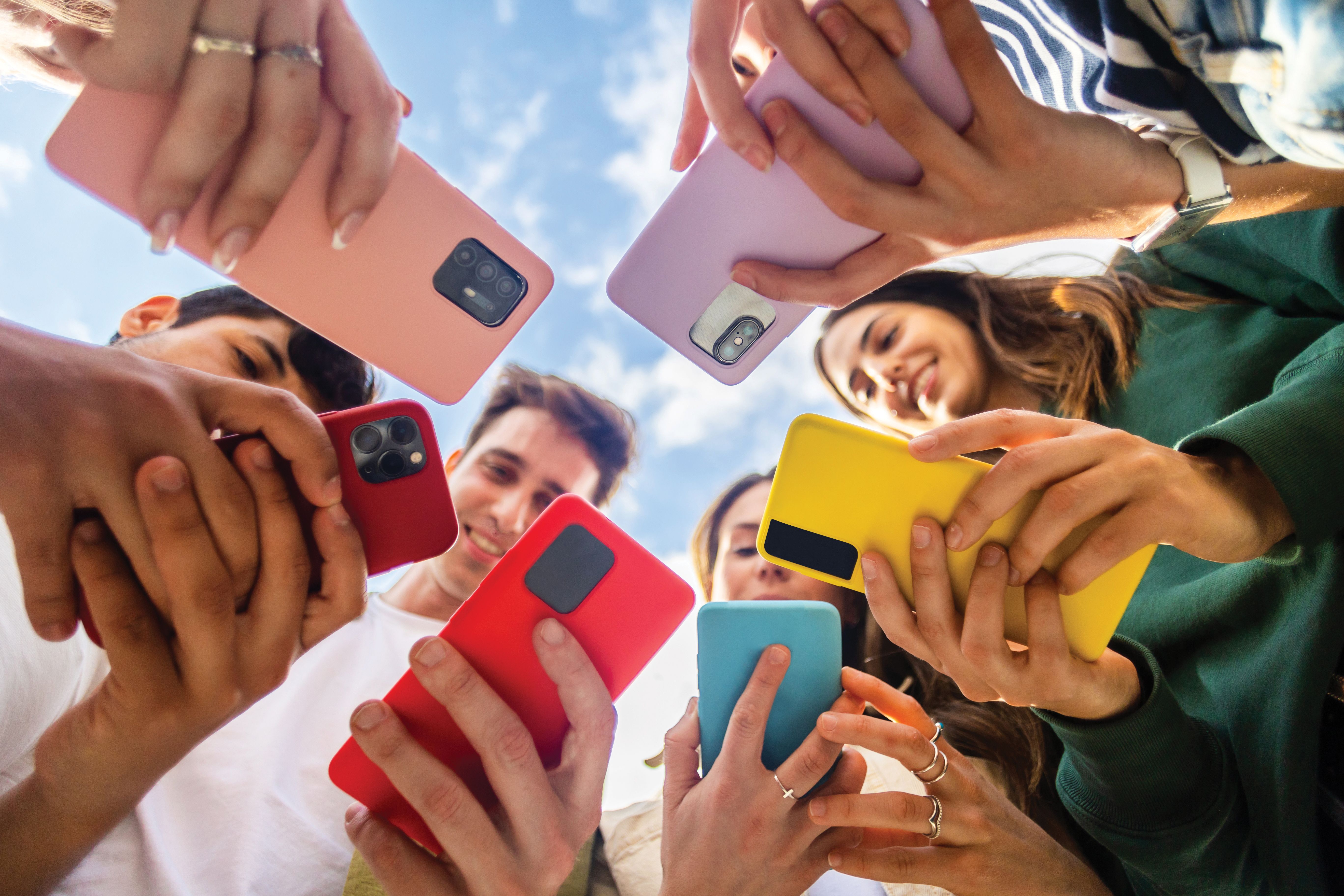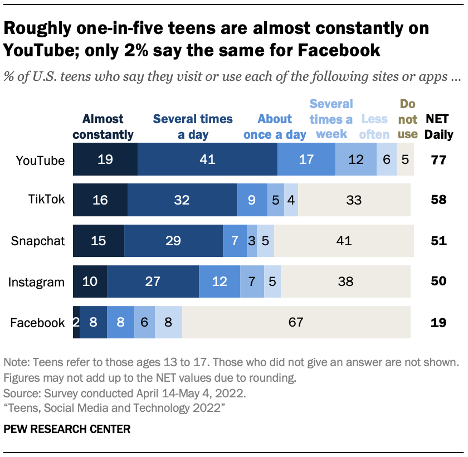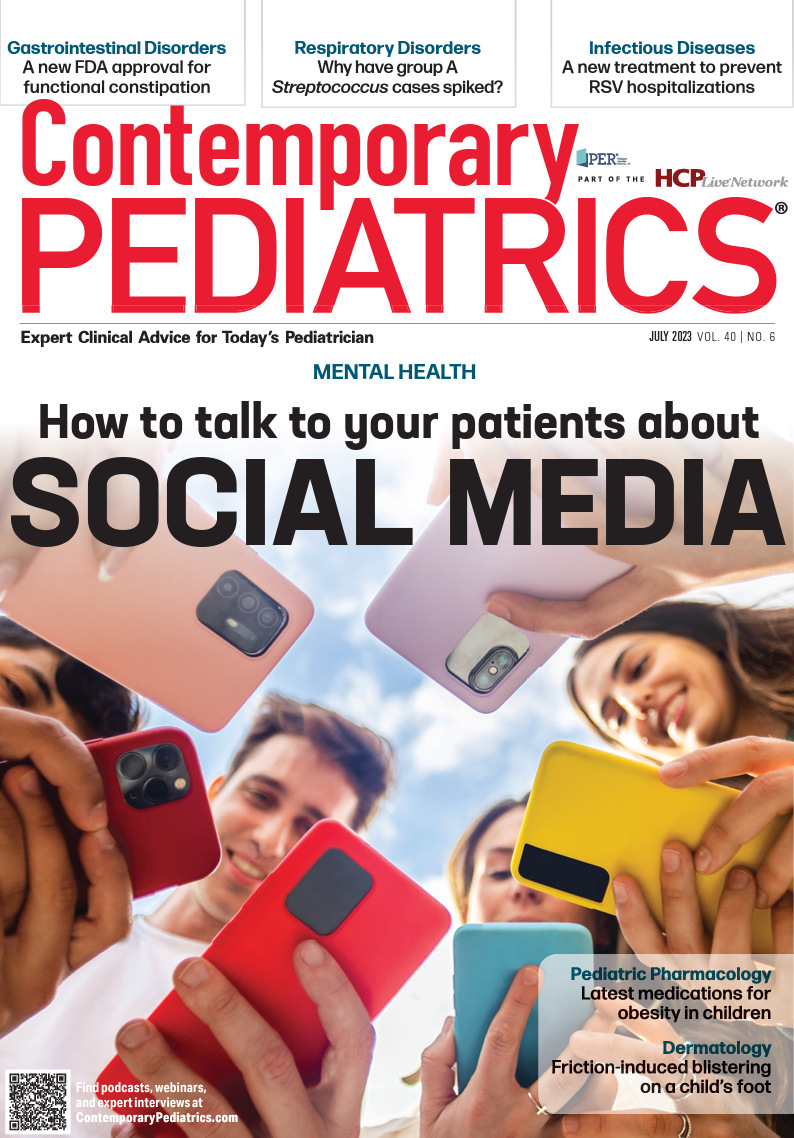Talking to teenagers about social media
The recent TikTok “Benadryl challenge” is just one example of the online dangers of shared videos among adolescents. Here is what pediatric health care providers should know—and how they can help.
Talking to teenagers about social media | Image Credit: © Xavier Lorenzo - © Xavier Lorenzo - stock.adobe.com.

Talking about TikTok at wellness or acute visits may seem inane at first glance, but our commitment to pediatric well-being demands a level of attention to social media no one ever expected. For the past several years, I’ve championed prosocial and educational uses for social media in the pediatric field. However, the use of social media by children and adolescents has been shown to have an impact on mental health, driving safety, and even fatal overdoses. The ongoing morbidity and, most recently, tragic fatality of the resurgence of the “Benadryl challenge” on TikTok posits a potent reminder of the life-threatening realities that misinformation and social media ushers into adolescents’ lives.1
The Benadryl challenge, which was first covered by this journal in 2021, has circulated via short videos on TikTok since 2020, encouraging adolescents to take large quantities of OTC diphenhydramine (Benadryl) to get high or hallucinate.1-3 Sharing videos of the challenge on TikTok thereafter may further draw in users by encouraging others to capture the challenge on video and reshare it. In the last few years, 2 teenagers in the United States died and a number of adolescents around the country were hospitalized after consuming large amounts of Benadryl.2 Adolescents may conflate the Benadryl challenge with a false sense of security if they have used the medicine previously in regular doses, misappropriately believing it is safe at any dose.
Adolescents have reported taking 12 to 14 Benadryl tablets for the challenge. In large quantities, diphenhydramine can have anticholinergic or antimuscarinic effects, causing dry mouth, delirium, hallucinations, tachycardia, coma, and even death.3 In 2020, the FDA issued a warning about the use of diphenhydramine in large doses, the Benadryl challenge, and risks for teenagers specifically.4 The FDA contacted TikTok and Benadryl drug maker Johnson & Johnson, which also issued a warning about the risks of overdose. Recommendations from both entities included education for adolescents and the public along with reminders to keep all medications, including Benadryl, out of reach of children. But the warnings, FDA involvement, increased awareness, and regulation at the company TikTok have not stopped the challenge from circulating. The hospitalization of a 13-year-old boy in New Jersey and the death of a 13-year-old boy in Ohio in spring 2023 urge ongoing work in education and awareness by pediatricians.2
Challenges urging risky ingestions are not new threats to pediatric health.5 The cinnamon challenge surged in 2012, followed by the Tide pod challenge, and then the nutmeg challenge. All similarly lured adolescents to ingest substances not intended for consumption (or in larger than recommended quantities) for a thrill or to achieve a high. When delivered via platforms like TikTok, the appeal may accelerate with the reinforcement that comes from “likes” and shares of videos capturing unknowing teenagers participating in the challenge. The speed of digital word of mouth increases the likelihood that the challenge is met before it can be blocked on the social channels by regulators.
Smartphone use and challenges
In the 16 years since the first iPhone went on the market,6 the experience of being a teenager has dramatically shifted. Look at any crowd of children and young adults, and the majority will have a smartphone in hand, capturing videos, taking selfies, sending texts, or leveraging social media. Our 2023 postpandemic reality is a culture where nearly every single adolescent in America has acquired a smartphone for connection. In national data, some teenagers are explaining to us that they are using their phones and social media tools “almost constantly” to stay connected to others.7 Adults have similar challenges with device use, but vulnerability to novel attention-stealing technology wed to their unique, critical cognitive development during adolescence makes the effect of social media on adolescents that much more profound. In 2021, the Pew Research Center found nearly 50% of teenagers say they are on the internet “constantly,” while approximately the same number say they worry that they are on their phones too much. Additionally, they report feeling “lonely” without their smartphone. With CDC data out in spring 2023 demonstrating historic levels of sadness in adolescents—two-thirds of girls report feelings of despair and sadness, for example—the stakes are extremely high.8
Smartphones afford us remarkable connection and convenience, bring peer-to-peer support, galvanize prosocial movements, and delight us. Teenagers report that smartphones help connect them with friends and learn new things.9 As clinicians, we also should be aware of how our pediatric patients use their phones to learn about health and wellness. The 2018 Hopelab and Well Being Trust Report found nearly 9 in 10 teenagers and young adults went online to find out information about their health, with 2 in 3 teenagers reported that they used mobile applications for health or fitness tracking or learning.10
But how we use them matters. The Pew Research Center’s most recent data confirms that nearly every teenager has access to a smartphone (95%) and nearly every teenager (95%) uses the social channel YouTube.7 One in 5 teenagers says they use YouTube “constantly” throughout the day.
Digital media takes our children away from other remarkable experiences (friendships in real life, outdoor time, boredom, family time, homework, sleep), and the ability of these platforms to not only grab teen attention, but maintain it, is novel.
There’s no question that social media use can enhance the well-being of children and teenagers in positive ways, but these online videos in places like TikTok can at times bring significant risk. While the focus of this piece is TikTok, one reminder is that all content made on one channel (ie, YouTube) can be reshared or repurposed elsewhere (ie, TikTok or Instagram).
What exactly is TikTok?
Not only is TikTok a space for creative videos, it is also a platform powered by algorithms and the speed of content sharing. It is now the second most commonly used app by adolescents, with two-thirds of teenagers using it regularly and 1 in 3 using it “several times daily.”7
In 2015, 75% of Americans aged 13 to 18 years owned a smartphone, and the current reality is that nearly every single teenager has one (95%).7 During the same years of nearly complete adoption of smartphone acquisition in this age group, TikTok’s platform uniquely grabbed their time and attention. In 2020, TikTok surpassed 2 billion downloads worldwide.11

The primary feature of TikTok is its short-form videos, typically ranging from 3 seconds to a few minutes in length. Users can record videos within the app or upload prerecorded content. TikTok provides various creative tools and features such as filters, effects, text overlays, and a vast library of licensed music that users can incorporate into their videos to augment or even distort the reality.
TikTok gained popularity in part because of the emphasis on creativity, entertainment, and daily trends. By design, adolescents can access hot topics, memes, and content that is having a “moment,” rapidly keeping them up-to-date with current online conversations. By design, TikTokers often participate in challenges, lip-syncing, dancing, comedy skits, do-it-yourself projects, and competitions. The platform draw is strong and has a huge community aspect by design, allowing users to follow others, like and comment on videos, and collaborate with friends or other creators. It’s built to keep adolescents connected to it, repeatedly urging them to share content.
One of the key aspects that sets TikTok apart is its algorithm-based “For You” page.10 This page displays a personalized feed of videos based on a user’s preferences, past interactions with others, and content. TikTok’s algorithm is known for its ability to quickly adapt and curate content that aligns with users’ interests, often leading to viral trends and challenges that move about the world rapidly without intervention, cautious thinking, regulation, or protection.
Regulation
With concerns about social media use only increasing, and increasing evidence of its role in nation’s pediatric mental health crisis, regulation must continue to evolve. Given the ubiquity of smartphones and the more than 3 hours of each day children and adolescents spend on their platforms, social media companies have faced relatively few restrictions. In the beginning, privacy concerns were tantamount, but over time, parents and pediatricians have become increasingly concerned with software algorithms and design implications on digital addiction, targeting, instigation of violence, racism, criminality, and misinformation.
In February 2019, TikTok paid over $5 million to the Federal Trade Commission to settle allegations that it had illegally collected personal information from children under the age of 13 without parental consent, in violation of the Children’s Online Privacy Protection Act.12 Further, under mounting scrutiny, the company implemented protections in March 2023 requiring users aged 13 to 17 years to re-login with their password after 60 minutes of use in an attempt to curb overuse.13 The company also now restricts use for those between the age of 13 and 15 years, disallows direct messaging for users under 16, and offers functions for family pairing. In time, research will help us learn if these changes decrease time spent on the platform, limit incessant scrolling, and/or improve safety for adolescents.
Over the last decade mounting data has shown how social tools have negatively impacted well-being, increasing levels of despair in adolescents and young adults. Surgeon General Vivek H. Murthy, MD, MBA, issued a national advisoryin May 2023 about the effects of social media on youth mental health.14 The advisory urged pediatricians, parents, researchers, and technologists to employ themselves to maximize the benefits of social media and minimize the harms. The current issue with the Benadryl challenge is a perfect example where we can help.
_____________________________________________________________
5 tips for pediatricians screening for social media use
- Check in with children and adolescents in your practice who have access to smartphones, as part of routine care. Digital devices are an important part of their relationships, education, and entertainment. Acknowledging the good that can come from connection on social media is important to build trust in the rules and discipline pediatric patients need as they navigate their online lives.
- Detail the risks of online challenges, specifically, the Benadryl challenge, with families, instructing and explaining about the dangers of taking more doses than recommended of OTC medications like diphenhydramine. Encourage families to talk with other parents and children to raise awareness in their communities.
- Encourage coviewing of media content. Talk to families about making a media plan collaboratively with their children and adolescents. Keep the plan as simple as possible so it’s easy to follow, as research shows complexity may not change use in teenagers.15 The family media plan from the American Academy of Pediatrics offers a tool in both English and Spanish to cocreate a plan with children and adolescents and to revisit and rework it over time.16 The plan can be printed and posted in a shared space at home for easy reminders and follow-through. The Digital Wellness Lab at Boston Children’s Hospital also offers resources and tools for families online.17
- Report inappropriate and dangerous content (you can do this on the individual platforms) and encourage adolescents and families to report content they discover on social channels like TikTok immediately.
- Remind children and adolescents to seek immediate help from adults about an acute overdose and to call Poison Control with any questions or concerns. As part of routine care, we can help pediatric patients add a few numbers to their smartphone contacts:
• 1-800-222-1222: Poison Control,available 24 hours a day, 7 days a week
• 988: The Suicide and Crisis Hotline,available 24 hours a day, 7 days a week for calls or texts/chats
• 911: Emergency services, if there is ever aconcern about a friend or peer in immediate danger from an overdose or life-threatening danger, even if part of any challenge.
For more from the July, 2023 issue of Contemporary Pediatrics®, click here.
References:
- Viral TikTok ‘Benadryl challenge’ claims life of 13-year-old boy. Psychiatrist.com. April 19, 2023. Accessed June 13, 2023. https://www.psychiatrist.com/news/viral-tiktok-benadryl-challenge-claims-life-of-13-year-old-boy
- Thompson, B. ‘Benadryl challenge’ that killed Ohio teen lands NJ boy in hospital; see mom’s warning. NBCNewYork.com. April 27, 2023. Updated on April 30, 2023. Accessed June 13, 2023. https://www.nbcnewyork.com/news/local/nj-teen-hospitalized-after-doing-dangerous-viral-online-trend-benadryl-challenge/4284219
- Minhaj F, Leonard J. Dangers of the TikTok Benadryl challenge. Contemporary Pediatrics. 2021;38(01). https://www.contemporarypediatrics.com/view/dangers-of-the-tiktok-benadryl-challenge
- FDA warns about serious problems with high doses of the allergy medicine diphenhydramine (Benadryl). FDA. September 24, 2020. Accessed June 10, 2023. https://www.fda.gov/drugs/drug-safety-and-availability/fda-warns-about-serious-problems-high-doses-allergy-medicine-diphenhydramine-benadryl
- Bean M. The rise of “elective injuries.” Becker’s Hospital Review. April 11, 2023. Accessed June 13, 2023. https://www.beckershospitalreview.com/patient-safety-outcomes/the-rise-of-elective-injuries.html
- Apple reinvents the phone with iPhone. News release. Apple; January 9, 2007. Accessed June 13, 2023.https://www.apple.com/newsroom/2007/01/09Apple-Reinvents-the-Phone-with-iPhone/
- Vogels EA, Gelles-Watnick R, Massarat N. Teens, social media and technology 2022. August 10, 2022. Accessed June 8, 2023. https://www.pewresearch.org/internet/2022/08/10/teens-social-media-and-technology-2022
- Youth risk behavior survey. CDC. Accessed June 10, 2023. https://www.cdc.gov/healthyyouth/data/yrbs/yrbs_data_summary_and_trends.htm
- Schaeffer K. Most U.S. teens who use cellphones do it to pass time, connect with others, learn new things. Pew Research Center. August 23, 2019. Accessed June 12, 2023. https://www.pewresearch.org/short-reads/2019/08/23/most-u-s-teens-who-use-cellphones-do-it-to-pass-time-connect-with-others-learn-new-things/
- Rideout V, Fox S. Digital health practices, social media use, and mental well-being among teens and young adults in the U.S. Hopelab and Well Being Trust. Summer 2018. Accessed June 6, 2023. https://hopelab.org/research/national-survey-2018/
- Leskin P. TikTok surpasses 2 billion downloads and sets a record for app installs in a single quarter. Business Insider. April 30, 2020. Accessed June 19, 2023. https://www.businessinsider.com/tiktok-app-2-billion-downloads-record-setting-q1-sensor-tower-2020-4
- Timberg C, Romm T. The U.S. government fined the app now known as TikTok $5.7 million for illegally collecting children’s data. Washington Post. February 27, 2019. Accessed June 12, 2023. https://www.washingtonpost.com/technology/2019/02/27/us-government-fined-app-now-known-tiktok-million-illegally-collecting-childrens-data/
- Keenan C. New features for teens and families on TikTok. TikTok. March 1, 2023. Accessed June 10, 2023. https://newsroom.tiktok.com/en-us/new-features-for-teens-and-families-on-tiktok-us
- Surgeon general issues new advisory about effects social media use has on youth mental health. US Department of Health and Human Services. News release. May 23, 2023. Accessed June 10, 2023.
- Moreno MA, Binger KS, Zhao Q, Eickhoff JC. Effect of a family media use plan on media rule engagement among adolescents: a randomized clinical trial. JAMA Pediatr. 2021;175(4):351-358. doi:10.1001/jamapediatrics.2020.5629
- Family media plan. American Academy of Pediatrics. Accessed June 12, 2023. https://www.healthychildren.org/english/fmp/pages/mediaplan.aspx#/
- Adolescent media use: mediation and online safety features. Boston Children’s Hospital Digital Wellness Lab. Accessed June 13, 2023. https://digitalwellnesslab.org/wp-content/uploads/Digital_Wellness_Lab_Pulse_Report_Mar-2023.pdf

Newsletter
Access practical, evidence-based guidance to support better care for our youngest patients. Join our email list for the latest clinical updates.
259 Prospect Plains Rd, Bldg H,
Cranbury, NJ 08512
All rights reserved.